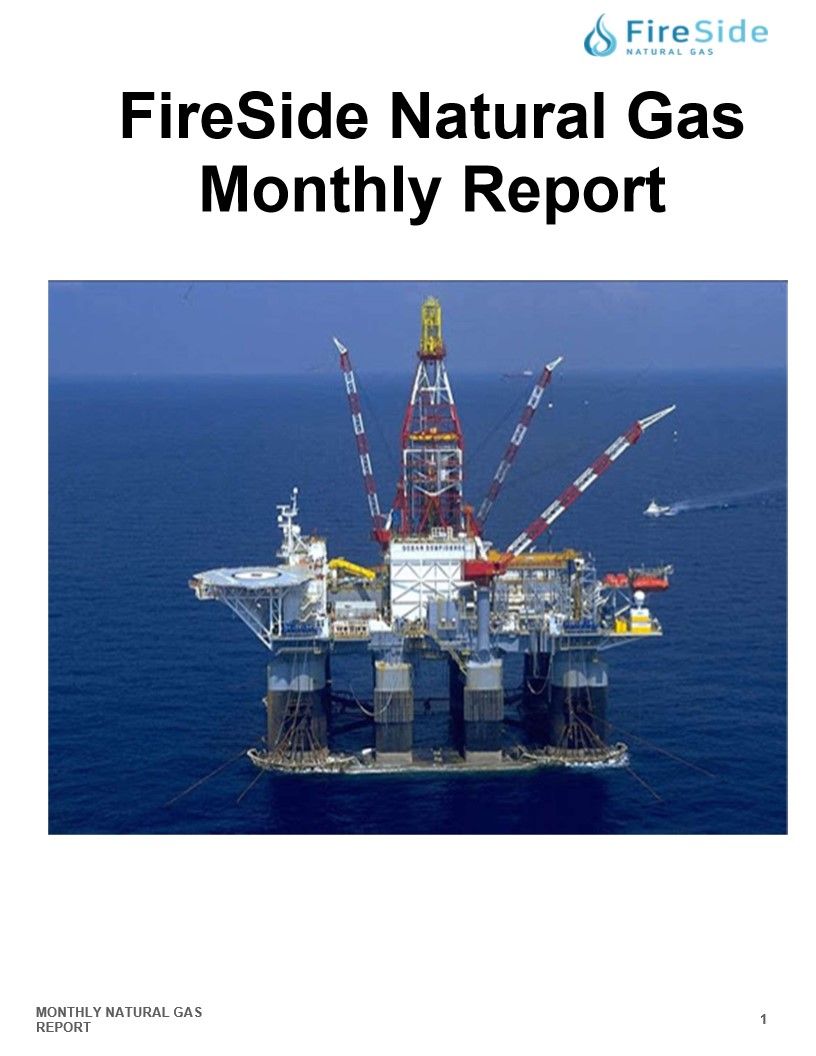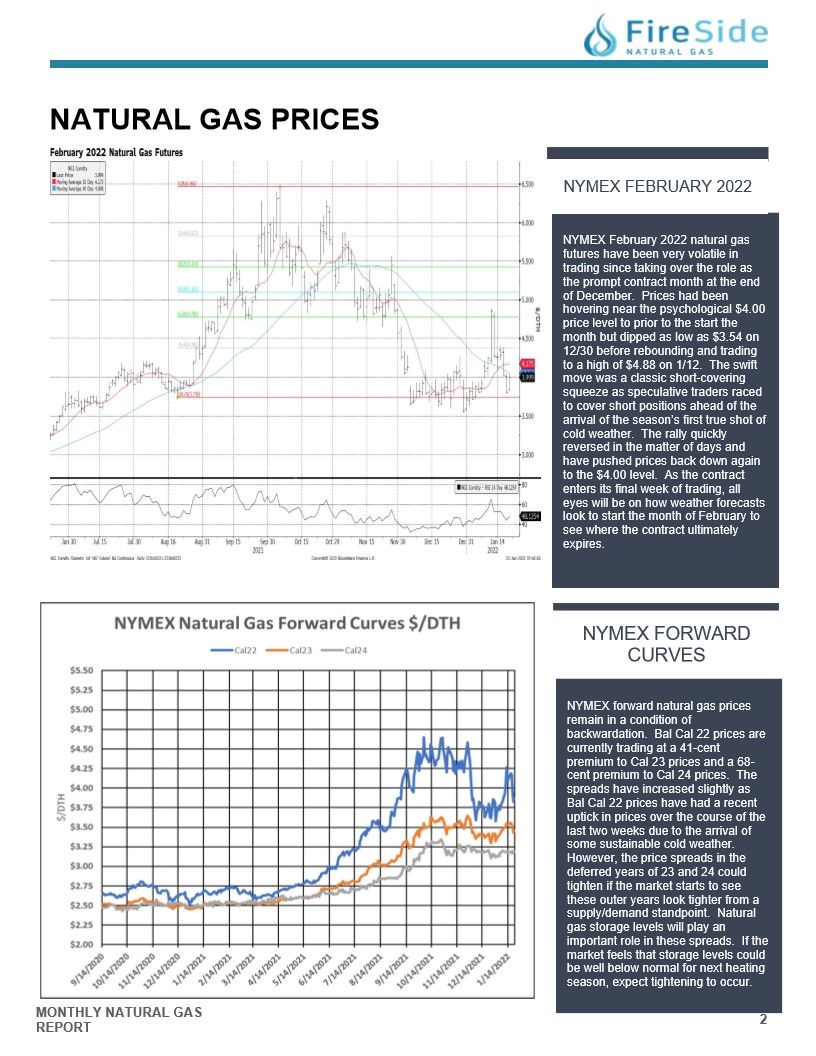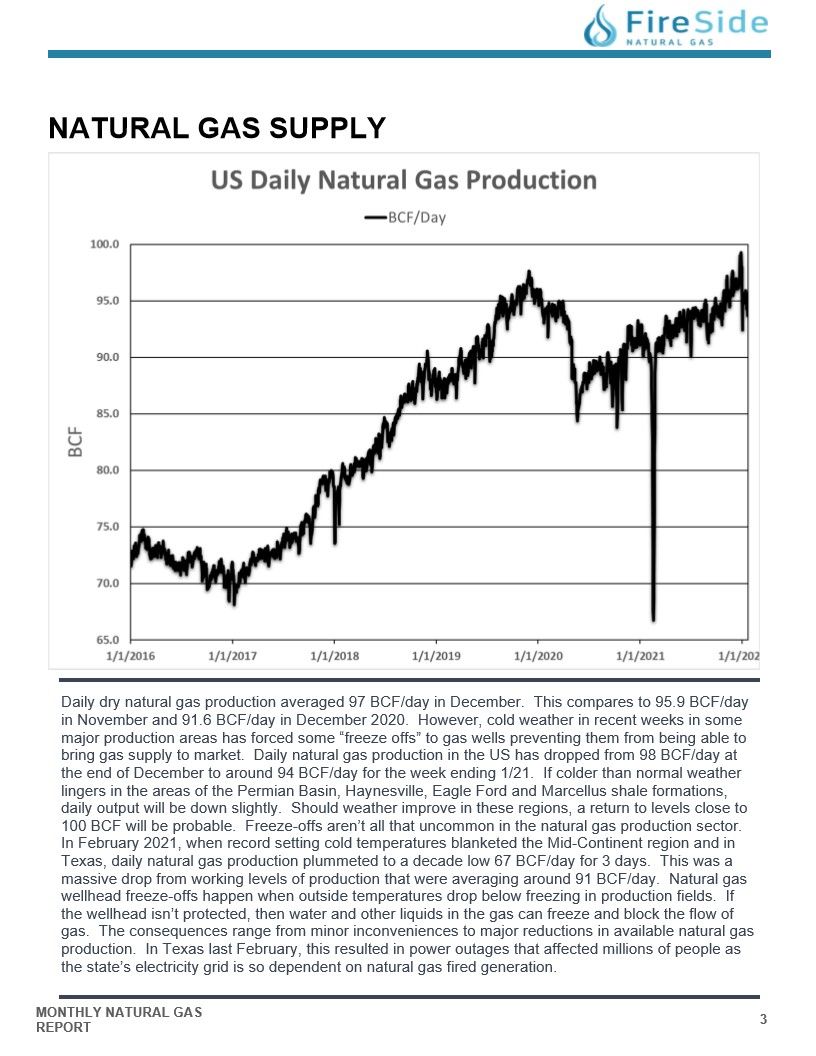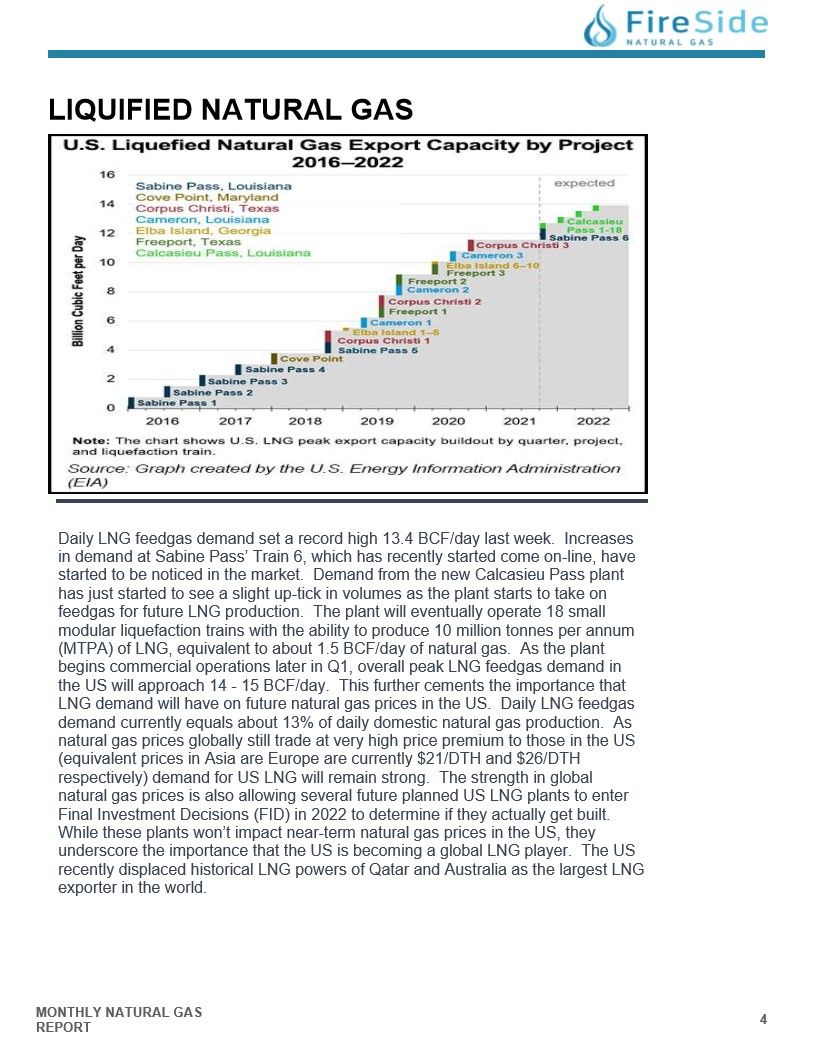The Monthly Natural Gas Market Newsletter - January Report
NATURAL GAS PRICES - NYMEX FEBRUARY 2022
NYMEX February 2022 natural gas
futures have been very volatile in
trading since taking over the role as
the prompt contract month at the end
of December. Prices had been
hovering near the psychological $4.00
price level to prior to the start the
month but dipped as low as $3.54 on
12/30 before rebounding and trading
to a high of $4.88 on 1/12. The swift
move was a classic short-covering
squeeze as speculative traders raced
to cover short positions ahead of the
arrival of the season's first true shot of
cold weather. The rally quickly
reversed in the matter of days and
have pushed prices back down again
to the $4.00 level. As the contract
enters its final week of trading, all
eyes will be on how weather forecasts
look to start the month of February to
see where the contract ultimately
expires.
NYMEX FORWARD
CURVES
NYMEX forward natural gas prices
remain in a condition of
backwardation. Bal Cal 22 prices are
currently trading at a 41-cent
premium to Cal 23 prices and a 68-
cent premium to Cal 24 prices. The
spreads have increased slightly as
Bal Cal 22 prices have had a recent
uptick in prices over the course of the
last two weeks due to the arrival of
some sustainable cold weather.
However, the price spreads in the
deferred years of 23 and 24 could
tighten if the market starts to see
these outer years look tighter from a
supply/demand standpoint. Natural
gas storage levels will play an
important role in these spreads. If the
market feels that storage levels could
be well below normal for next heating
season, expect tightening to occur.
NATURAL GAS SUPPLY - US PRODUCTION
Daily dry natural gas production averaged 97 BCF/day in December. This compares to 95.9 BCF/day
in November and 91.6 BCF/day in December 2020. However, cold weather in recent weeks in some
major production areas has forced some "freeze offs" to gas wells preventing them from being able to
bring gas supply to market. Daily natural gas production in the US has dropped from 98 BCF/day at
the end of December to around 94 BCF/day for the week ending 1/21. If colder than normal weather
lingers in the areas of the Permian Basin, Haynesville, Eagle Ford and Marcellus shale formations,
daily output will be down slightly. Should weather improve in these regions, a return to levels close to
100 BCF will be probable. Freeze-offs aren't all that uncommon in the natural gas production sector.
In February 2021, when record setting cold temperatures blanketed the Mid-Continent region and in
Texas, daily natural gas production plummeted to a decade low 67 BCF/day for 3 days. This was a
massive drop from working levels of production that were averaging around 91 BCF/day. Natural gas
wellhead freeze-offs happen when outside temperatures drop below freezing in production fields. If
the wellhead isn't protected, then water and other liquids in the gas can freeze and block the flow of
gas. The consequences range from minor inconveniences to major reductions in available natural gas
production. In Texas last February, this resulted in power outages that affected millions of people as
the state's electricity grid is so dependent on natural gas fired generation.
LIQUIFIED NATURAL GAS
Daily LNG feedgas demand set a record high 13.4 BCF/day last week. Increases
in demand at Sabine Pass' Train 6, which has recently started come on-line, have
started to be noticed in the market. Demand from the new Calcasieu Pass plant
has just started to see a slight up-tick in volumes as the plant starts to take on
feedgas for future LNG production. The plant will eventually operate 18 small
modular liquefaction trains with the ability to produce 10 million tonnes per annum
(MTPA) of LNG, equivalent to about 1.5 BCF/day of natural gas. As the plant
begins commercial operations later in Q1, overall peak LNG feedgas demand in
the US will approach 14 - 15 BCF/day. This further cements the importance that
LNG demand will have on future natural gas prices in the US. Daily LNG feedgas
demand currently equals about 13% of daily domestic natural gas production. As
natural gas prices globally still trade at very high price premium to those in the US
(equivalent prices in Asia are Europe are currently $21/DTH and $26/DTH
respectively) demand for US LNG will remain strong. The strength in global
natural gas prices is also allowing several future planned US LNG plants to enter
Final Investment Decisions (FID) in 2022 to determine if they actually get built.
While these plants won't impact near-term natural gas prices in the US, they
underscore the importance that the US is becoming a global LNG player. The US
recently displaced historical LNG powers of Qatar and Australia as the largest LNG
exporter in the world.
NATURAL GAS STORAGE - STORAGE ANALYSIS
Natural gas storage helps "balance" the US natural gas market. The highest level of gas ever recorded in storage was back on
11/11/2016 at 4.047 TCF. The US market now considers 4.0 TCF as the new "normal" for adequate levels of gas storage entering the
winter heating season. Inventory levels reached 3.958 TCF last November. Storage exited the 2020/2021 heating season at 1.750 TCF.
Current storage levels are at 2.810 TCF as the 2021/2022 heating season is starting to peak. Inventory levels are currently 7.4% below
year-ago levels and 1.2% below the previous 5-year average. In December, storage inventories declined by 369 BCF during the month.
This compares to 609 BCF that was withdrawn in December 2020. Recent cold weather seen thus far in January has finally spurred
heating demand. For the week ending 1/14, the EIA reported the largest withdrawal of the season so far at 206 BCF. Based on demand
data, projections for the week ending 1/21 will provide another withdrawal in the 200+ BCF range. With colder than normal weather
forecasted for the major consuming regions in the Midwest and Northeast thru month's end, large weekly withdrawals for the remainder of
January look likely. Depending on how weather looks in February, the end of season inventory levels is still forecasted to see storage
levels around 1.5 TCF entering the injection season. Reaching a storage level near 4.0 TCF for heating season 2022/2023 is unlikely.
Energy Related Articles and Stories
https://www.texastribune.org/2022/01/19/texas-pipeline-gas-power-winter/






